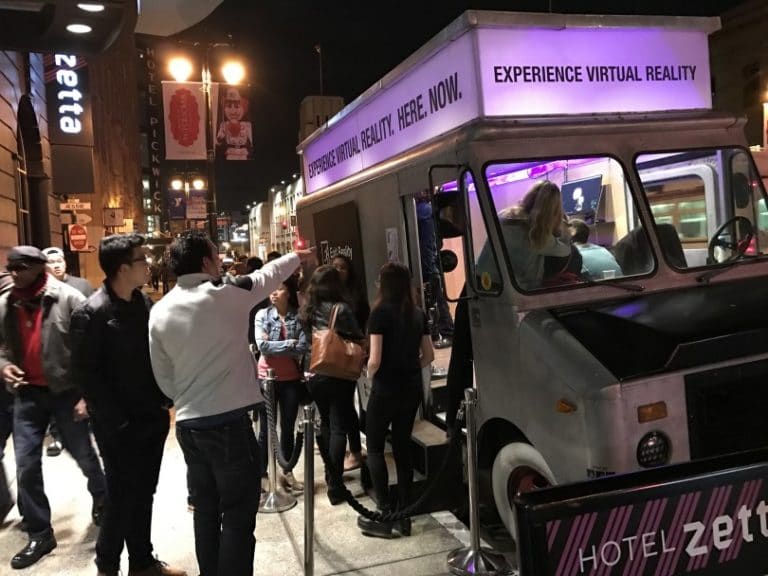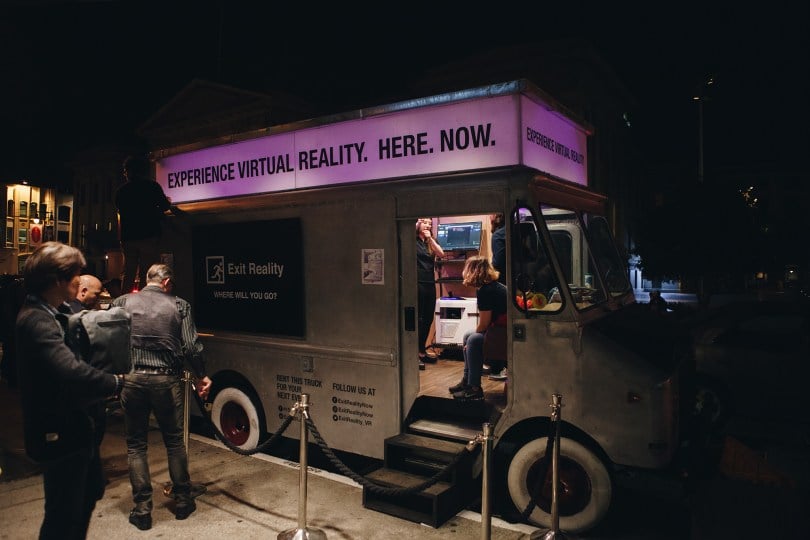
With roughly 17 million headsets sold to date, VR is penetrating consumer markets quickly. But it’s still far behind the scale of the current ubiquitous consumer hardware: 2.6 billion global smartphones.
Though it doesn’t have an adoption problem in terms of ability to wow new users, VR’s cost and hardware complexity raise barriers to getting that initial taste to the masses. That’s why we’re bullish on VR arcades and other “location based” installations.
Exit Reality is a company within that general category, but differentiated in lots of ways. It has a few kinds of installations including mobile VR trucks, and fixed installations like its hotel Zetta “VR Cube” in San Francisco, where I visited the company this week.
Though the advantages of any VR installation are varied, they’re best exhibited by this flagship location, where a turnkey VR rig sits just off the lobby. A large window, exposes VR live experiences to 5th-street foot traffic — a great promotional tool for the hotel.
Moreover, the “cube” is a big selling point for the boutique SOMA hotel to book events (think: corporate parties) in its ground floor bar and lobby. Exit Reality manages the service end-to-end, including a guide during events to administer timed VR experiences.

These can last three minutes or longer according to Exit Reality’s Trace Wax, depending on the size of the crowd and the context of the event. A virtual queue will sequence these appointments and alert event guests when it’s their turn to enter the cube.
It doesn’t charge individuals in most situations because it doesn’t want the experience to seem “transactional. Arguably, the promotional bang is more valuable for Exit Reality, given legions of new brand advocates that walk away from these events.
Moving forward, CEO Yoni Koenig sees several areas for vertical expansion including concerts, trade shows and private parties. Some of these are temporal — utilizing its trucks — and others could be more fixed, such as Hotel Zetta.
Another opportunity for fixed installations we discussed is retail. Not only is it something that can attract foot traffic due to VR’s inherent appeal, but VR content/experiences can incorporate a given retailer’s products or brand promotions.
Content is in fact is a key part of the equation in all installations, not surprisingly. Exit Reality’s criteria for content selection involves a combination of audience sentiment (what’s performing best) and contextual relevance to the location or event.
Relaxing environments such as a hotel or a spa, for example, can utilize VR content such as theBlu. Anything in retail or commercial spaces could conceivably show branded or sponsored immersive content from the products they carry.

In all cases, the underlying goal is to seed VR demand by bringing it to more consumers. As we’ve said, VR arcades will fill a gap before home ownership reaches ubiquity; just like arcades of the 70’s and 80s preceded home video game console ubiquity.
Koenig prefers the historical analogy of stereo sound, which was around for years before RCA seeded demand for the new standard by sponsoring its use in the 1940 film release of Fantasia. Soon everyone wanted it, and two years later it was a standard.
Meanwhile, don’t liken Exit Reality to a VR Arcade…even though I’ve already applied that general categorization. The company wants to differentiate with higher-end premium VR installations, which is evident in the boutique hotel approach
“This isn’t an arcade, it’s more like a circus tent,” says Wax. On one level, his comment characterizes the attention and curiosity in the faces of 5th Street passers-by at night, staring into the Zetta Hotel window at the florescent glow of VR experiences underway.
